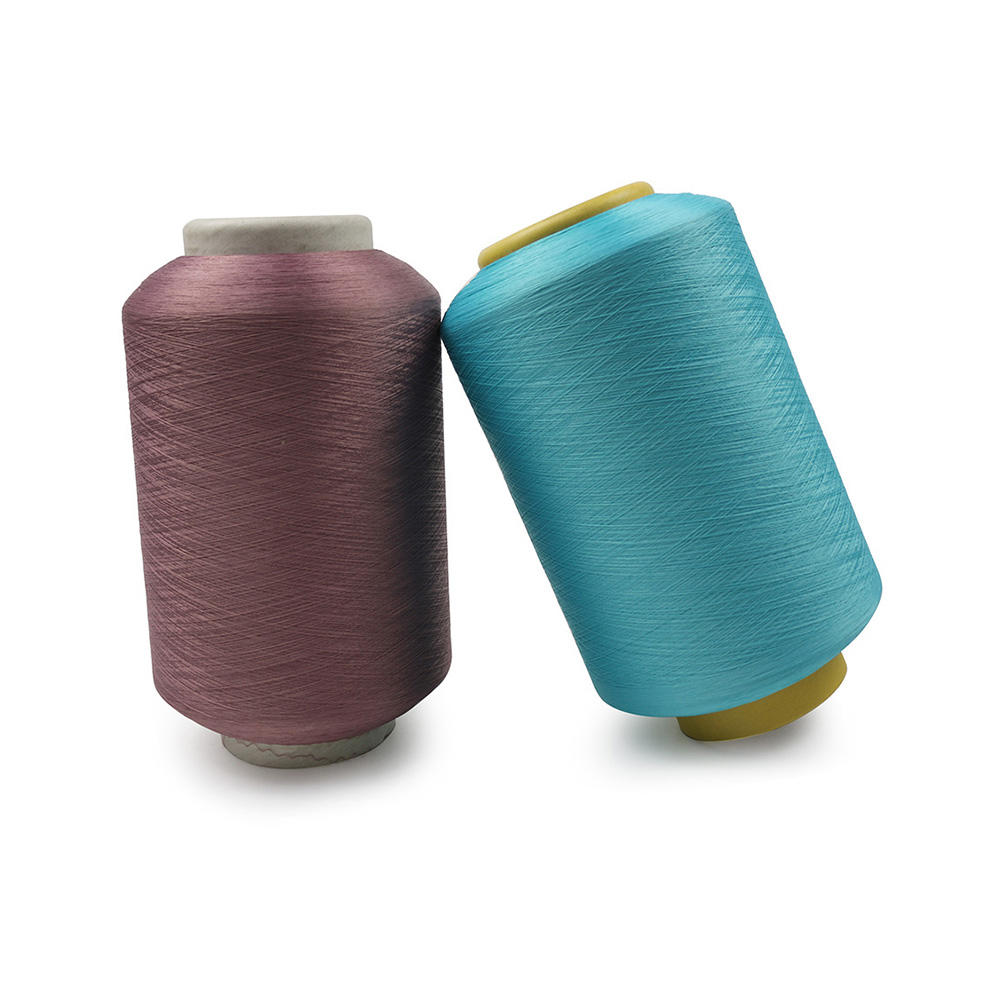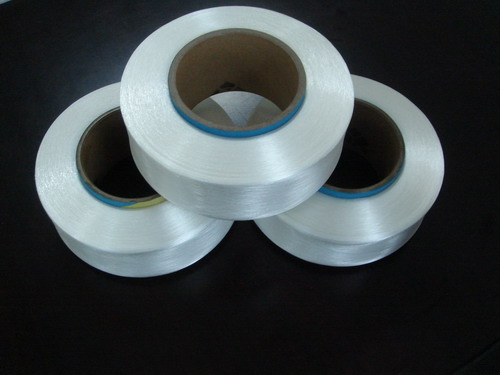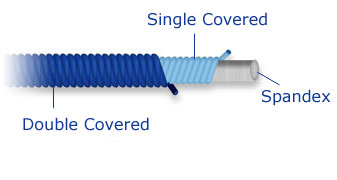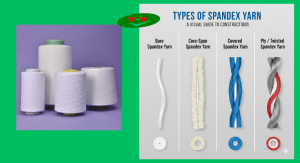The rise of covered spandex yarn export as a global export phenomenon is a testament to the textile industry’s relentless pursuit of innovation and the ever-evolving consumer demand for comfort, style, and functionality. This versatile material, which combines the stretch and recovery properties of spandex with the aesthetic appeal and durability of other fibers, has become a staple in a wide range of apparel and textile applications, from activewear to casual wear and beyond.
Navigating the Diverse Applications of Covered Spandex Yarn
Covered spandex yarn’s versatility is one of its greatest strengths, allowing it to seamlessly integrate into diverse product categories. In the activewear and athleisure sectors, the yarn’s exceptional stretch and moisture-wicking properties make it a natural choice for garments that need to move with the body and keep the wearer comfortable during physical activity. From leggings and sports bras to athletic shorts and compression socks, covered spandex yarn is the backbone of modern performance apparel.
Beyond activewear, the material’s versatility extends to the realm of swimwear, where its chlorine resistance and quick-drying capabilities are highly valued. In the casual wear segment, covered spandex yarn lends a contemporary, comfortable touch to jeans, dresses, and other everyday garments, catering to the growing demand for fashionable yet functional clothing.
The applications of covered spandex yarn even reach into the medical textiles industry, where its stretchability, breathability, and durability make it an ideal choice for garments worn by healthcare professionals and patients. From compression stockings to surgical gowns, the material’s unique properties contribute to enhanced patient comfort and caregiver performance.
Exploring the Technological Advancements Shaping Covered Spandex Yarn
The evolution of covered spandex yarn has been driven by continuous technological advancements in the textile industry. Improvements in yarn production processes, such as enhanced spinning and covering techniques, have resulted in higher-quality, more consistent covered spandex yarn. These advancements have not only improved the material’s performance characteristics but also expanded its applications, making it a more versatile and desirable option for manufacturers and consumers alike.
Concurrent developments in materials science have further enriched the covered spandex yarn landscape. The introduction of innovative cover fibers, such as specialty nylons and polyesters, has enabled the creation of yarns with unique aesthetic and functional properties. These advancements have allowed manufacturers to tailor the yarn’s appearance, texture, and overall performance to meet the specific needs of their target markets.
As the industry continues to push the boundaries of what’s possible, the future of covered spandex yarn holds immense promise. From the integration of sustainable materials to the incorporation of advanced technologies like smart textiles, the covered spandex yarn of tomorrow is poised to redefine the standards of comfort, durability, and environmental responsibility.
Exploring the Export Dynamics of Covered Spandex Yarn

The global export market for covered spandex yarn has become a thriving and highly competitive landscape, with major players from Asia leading the charge. Countries like China, South Korea, and Taiwan have emerged as the dominant exporters, leveraging their manufacturing prowess, technological advancements, and strategic supply chain management to capture a significant share of the global market.
The Rise of Asian Exporters
China, in particular, has solidified its position as the world’s largest exporter of covered spandex yarn, boasting an expansive production capacity and a well-established export infrastructure. The country’s ability to produce high-quality yarns at competitive prices, combined with its strategic location and efficient logistics, has made it a preferred supplier for many international textile manufacturers.
South Korea, known for its expertise in specialty textile production, has also carved out a significant niche in the covered spandex yarn export market. Its manufacturers are renowned for their attention to quality and innovation, catering to the needs of discerning customers in the sportswear, medical, and high-end fashion segments.
Taiwan, too, has emerged as a formidable player in the global covered spandex yarn export landscape. The island nation’s manufacturers have diversified their product offerings, enabling them to serve a wide range of applications, from activewear to industrial textiles.
Navigating Global Trade Dynamics
The success of these Asian exporters has been driven by a combination of factors, including their ability to leverage economies of scale, invest in state-of-the-art production facilities, and adapt to evolving market demands. However, the covered spandex yarn export market is not without its challenges.
Fluctuations in raw material prices, particularly for the core spandex component, can significantly impact the cost competitiveness of exporters. Additionally, the industry faces increasing scrutiny regarding environmental sustainability, leading manufacturers to explore more eco-friendly production methods and materials.
Navigating the complex web of global trade regulations and tariff structures is another key consideration for covered spandex yarn exporters. Staying abreast of shifting trade policies and adapting their strategies accordingly is crucial for maintaining a strong presence in the international market.
Exploring Emerging Markets and Diversification Strategies
As the global demand for covered spandex yarn continues to grow, exporters are also exploring opportunities in emerging markets. Regions like Southeast Asia, Latin America, and parts of Africa present untapped potential, with rising middle-class populations and increasing demand for high-quality, functional apparel.
To capitalize on these opportunities, exporters are diversifying their product portfolios, exploring new applications, and forging strategic partnerships with local manufacturers and distributors. By adapting their offerings to the unique preferences and requirements of these emerging markets, they can unlock new avenues for growth and solidify their position as global leaders in the covered spandex yarn export industry.
Key Players in the Covered Spandex Yarn Export Industry

The covered spandex yarn export market is dominated by a few key players, each with its own unique strengths and strategies. Understanding the competitive landscape and the strategies employed by these industry leaders can provide valuable insights into the dynamics shaping the global export market.
China: The Juggernaut of Covered Spandex Yarn Exports
China’s dominance in the covered spandex yarn export market is unparalleled. The country’s vast manufacturing capabilities, efficient supply chain, and cost-competitiveness have propelled it to the forefront of the industry. Major Chinese players, such as Zhejiang Huafon Spandex, Hyosung, and Invista, have leveraged their scale, technical expertise, and strategic partnerships to capture a significant share of the global market.
These companies have not only mastered the production of high-quality covered spandex yarn but have also invested heavily in research and development to stay ahead of the curve. Their ability to adapt to changing consumer preferences and regulatory requirements has been a key driver of their success in the export market.
South Korea: Specializing in Premium Covered Spandex Yarn
South Korean manufacturers have carved out a niche in the covered spandex yarn export market by focusing on premium, specialty products. Companies like Hyosung, Kolon Industries, and Creora are known for their commitment to quality, innovative product development, and close collaboration with their customers.
These South Korean exporters have leveraged their technical expertise to create covered spandex yarns with enhanced performance characteristics, such as superior stretch, moisture management, and thermal regulation. Their focus on delivering tailored solutions for specific applications, particularly in the sportswear and medical sectors, has earned them a reputation for excellence in the global market.
Taiwan: Diversifying the Covered Spandex Yarn Export Portfolio
Taiwan’s covered spandex yarn exporters have distinguished themselves through their ability to diversify their product offerings and cater to a wide range of applications. Companies like Formosa Taffeta, Nan Ya Plastics, and Far Eastern New Century have invested in research and development to expand their product portfolios, ranging from basic covered spandex yarns to highly specialized variants for industrial and technical textiles.
This diversification strategy has allowed Taiwanese exporters to remain agile and responsive to evolving market demands. By offering a broad spectrum of covered spandex yarn options, they have been able to maintain a strong presence in the global export market, catering to the needs of clients in various industries.
Emerging Players and the Pursuit of Innovation
While the covered spandex yarn export market is dominated by the major players from Asia, the industry is also witnessing the emergence of newer, innovative players. These companies, often hailing from other regions, are seeking to disrupt the status quo by introducing novel materials, production techniques, and business models.
For instance, European and North American manufacturers are exploring the integration of sustainable fibers, such as recycled polyester and biodegradable alternatives, into their covered spandex yarn offerings. This focus on environmental responsibility aligns with the growing consumer demand for more eco-friendly textile products.
Similarly, manufacturers in developing economies are leveraging their unique regional expertise and access to local resources to carve out their own niches in the global covered spandex yarn export market. These emerging players are challenging the established players, driving further innovation and diversification within the industry.
The Future of Covered Spandex Yarn Exports: Emerging Markets and Innovations

As the global demand for covered spandex yarn continues to surge, the future of the export market holds immense promise. Two key trends are shaping the industry’s trajectory: the exploration of emerging markets and the pursuit of innovative product development.
Tapping into Emerging Markets: Unlocking Untapped Potential
The rapid economic growth and rising middle-class populations in regions like Southeast Asia, Latin America, and parts of Africa have created a fertile ground for covered spandex yarn exporters. These emerging markets present a wealth of untapped potential, as consumers in these regions increasingly embrace the demand for comfortable, functional, and fashionable apparel.
Exporters are focusing on understanding the unique preferences and requirements of these emerging markets, adapting their product offerings accordingly. This may involve developing covered spandex yarns that cater to local climatic conditions, cultural preferences, or price points that resonate with the local consumer base.
Furthermore, exporters are forging strategic partnerships with local manufacturers, distributors, and retailers to establish a strong foothold in these markets. By leveraging local expertise and distribution networks, they can navigate the nuances of each region and overcome potential barriers to entry.
Driving Innovation: Shaping the Future of Covered Spandex Yarn
Concurrent with the exploration of emerging markets, the covered spandex yarn export industry is witnessing a surge of innovation. Manufacturers are continuously pushing the boundaries of what’s possible, driven by the ever-evolving needs of consumers and the imperative to stay ahead of the competition.
One key area of innovation is the integration of sustainable materials into covered spandex yarn. The growing awareness of environmental impact has led to the development of eco-friendly alternatives, such as recycled polyester, biodegradable fibers, and even organic cotton blends. By offering these sustainable options, exporters can cater to the rising demand for environmentally conscious textile products.
Advancements in production technologies are also transforming the covered spandex yarn landscape. Innovations in areas like smart textiles, digital printing, and advanced finishing techniques are enabling the creation of covered spandex yarns with enhanced functionalities, improved aesthetics, and increased versatility. These technological breakthroughs are opening up new avenues for exporters to differentiate their offerings and cater to the diverse needs of their global clientele.
Furthermore, the incorporation of data-driven insights and artificial intelligence is revolutionizing the way exporters approach product development, supply chain management, and customer engagement. By leveraging these cutting-edge tools, manufacturers can optimize their operations, anticipate market trends, and deliver tailored solutions to their clients more efficiently.
Understanding the Demand Drivers for Covered Spandex Yarn Exports
The exponential growth of the covered spandex yarn export market can be attributed to a confluence of factors, with the rising global demand for comfortable, functional, and fashionable apparel being at the forefront.
The Athleisure Boom and the Demand for Performance Fabrics
The meteoric rise of the athleisure trend, where activewear is seamlessly integrated into everyday wardrobes, has been a significant driver of the covered spandex yarn export market. Consumers worldwide are increasingly seeking garments that can seamlessly transition from the gym to the street, and covered spandex yarn’s exceptional stretch, moisture-wicking, and durability properties make it an ideal choice for this category.
Sportswear and activewear manufacturers have been at the forefront of this demand, incorporating covered spandex yarn into a wide range of products, from leggings and sports bras to athletic shorts and compression socks. As the appetite for high-performance, comfortable clothing continues to grow, the export market for covered spandex yarn is poised to soar.
The Rise of the Global Middle Class and the Demand for Affordable Luxury
Another key driver of the covered spandex yarn export market is the rapid expansion of the middle class, particularly in emerging economies. As disposable incomes rise and consumer aspirations shift, there is a growing demand for fashionable, quality clothing that offers both style and comfort.
Covered spandex yarn, with its ability to provide a contemporary, high-end look and feel, has become a preferred material for manufacturers catering to this burgeoning middle-class market. Exporters have leveraged their production capabilities and supply chain efficiencies to offer covered spandex yarn-based garments at accessible price points, satisfying the demand for affordable luxury.
The Increasing Emphasis on Comfort and Functionality
Across the globe, consumers are placing a greater emphasis on comfort and functionality in their clothing choices. The COVID-19 pandemic has further accentuated this trend, as people spend more time in casual, comfortable attire while working from home or engaging in leisure activities.
Covered spandex yarn’s inherent stretch, breathability, and versatility make it an ideal material for addressing this growing demand. From everyday casual wear to specialized medical textiles, the yarn’s ability to provide a comfortable, form-fitting experience has positioned it as a go-to choice for manufacturers and consumers alike.
The Influence of Evolving Fashion Trends and Consumer Preferences
The covered spandex yarn export market is also closely tied to the dynamic nature of global fashion trends. As consumer preferences shift, driven by factors such as cultural influences, social media, and personal style, manufacturers must adapt their offerings to cater to these changing demands.
Exporters who can quickly identify and respond to emerging fashion trends, integrating covered spandex yarn into innovative product designs, are poised to capture a larger share of the global market. This agility and responsiveness to evolving consumer preferences are crucial in maintaining a competitive edge in the highly dynamic textile industry.
The Role of Technology in Enhancing Covered Spandex Yarn Exports
The covered spandex yarn export market has been profoundly shaped by the continuous advancements in textile technology. From production processes to material science, technological innovations have been a driving force behind the industry’s growth and evolution.
Advancements in Yarn Production Techniques
The covered spandex yarn production process has undergone significant refinements, driven by technological progress. Improvements in spinning, covering, and finishing techniques have enabled manufacturers to achieve higher levels of consistency, quality, and efficiency in their output.
For instance, the introduction of advanced yarn covering machines has allowed for more precise control over the tension and speed of the spandex and cover fibers, resulting in a more uniform and stable final product. Similarly, innovations in finishing processes, such as the use of specialized coatings or treatments, have enhanced the yarn’s performance characteristics, such as its abrasion resistance, moisture management, and overall durability.
These technological advancements have not only improved the quality of covered spandex yarn but have also enabled exporters to scale up production and meet the growing global demand. By streamlining their operations and optimizing their manufacturing processes, exporters can maintain their competitive edge in the international market.
Innovations in Material Science and Product Development
Alongside advancements in production techniques, the covered spandex yarn export market has benefited from innovations in material science. The development of new and improved cover fibers, such as specialty nylons, polyesters, and even natural fibers like cotton, has expanded the range of possibilities for covered spandex yarn.
These material innovations have allowed exporters to create covered spandex yarns with unique aesthetic and functional properties, catering to the diverse needs of their global clientele. From enhanced moisture-wicking and odor-control capabilities to improved thermal regulation and stretch recovery, the incorporation of advanced fibers has enabled the creation of highly specialized covered spandex yarn products.
Furthermore, the integration of smart textile technologies, such as embedded sensors and microencapsulated additives, has opened up new avenues for exporters to differentiate their offerings. These innovative covered spandex yarns can provide enhanced performance, monitoring, and even self-cleaning functionalities, making them attractive to manufacturers in various industries, from sportswear to medical textiles.
Data-Driven Insights and Artificial Intelligence
The covered spandex yarn export market is also benefiting from the integration of data-driven insights and artificial intelligence (AI) technologies. Exporters are leveraging these tools to optimize their operations, improve supply chain management, and enhance customer engagement.
By leveraging data analytics, exporters can gain valuable insights into market trends, customer preferences, and supply chain dynamics. This information can inform their product development strategies, allowing them to anticipate and respond to the evolving demands of the global market more effectively.
Furthermore, the application of AI-powered algorithms in areas like demand forecasting, inventory optimization, and dynamic pricing can help exporters streamline their operations, reduce waste, and maintain a competitive edge. These technological advancements enable exporters to make more informed decisions, enhance their efficiency, and ultimatelymaximize their profitability in the covered spandex yarn export market.
Navigating Trade Barriers and Regulations in the Covered Spandex Yarn Export Market
As the global covered spandex yarn market continues to expand, exporters must be acutely aware of the trade barriers and regulations that can impact their operations. Navigating this complex landscape requires a full understanding of international trade agreements, tariffs, and local regulations applicable to textile exports.
Countries often impose specific tariffs on imported textiles, which can significantly influence pricing and competitiveness in various markets. Understanding these tariffs and how they compare across different regions is essential for exporters aiming to maximize their market share. In addition to tariffs, bilateral and multilateral trade agreements can provide exporters with advantageous terms that facilitate smoother access to key markets. For example, preferential trade agreements may lower or eliminate duties on covered spandex yarn, thereby enhancing an exporter’s appeal in price-sensitive markets.
Another critical aspect involves compliance with regional standards and certification requirements. Importing countries frequently have stringent regulations governing material safety, environmental impact, and labor practices. Failure to comply with these regulations can lead to costly fines or even bans from selling in specific markets. As a result, maintaining up-to-date knowledge of these regulatory frameworks is not merely optional; it is a crucial component of any successful export strategy.
Understanding Local Market Conditions
Exporters must also invest time and resources into understanding the local market conditions where they plan to sell covered spandex yarn. Each region may exhibit unique consumer behavior, preferences, and economic factors that can significantly affect demand.
For instance, emerging economies show varied responses to fashion trends compared to well-established markets. An effective market-entry strategy often involves localized research that addresses cultural sensibilities and purchasing behavior.
Furthermore, building relationships with local distributors or manufacturers can be invaluable in gaining insight into the competitive landscape and identifying potential partnerships. Collaborating with local entities not only enhances market knowledge but may also alleviate some logistical challenges related to distribution and sales.
Sustainability and Ethical Considerations
In today’s climate-conscious world, sustainability and ethical practices are becoming increasingly pivotal in driving covered spandex yarn exports. Consumers and regulatory bodies alike are prioritizing environmentally friendly products, compelling manufacturers and exporters to reassess their strategies.
The Push for Eco-Friendly Materials
The textile industry has long been criticized for its environmental footprint, prompting a substantial move towards sustainability. Exporters of covered spandex yarn are keenly addressing these concerns by exploring eco-friendly materials and production methods. Advanced fibers made from recycled plastics or organic cotton are rising in popularity.
Manufacturers are investing in research to create biodegradable alternatives or yarns featuring improved durability that extends product life cycles. By promoting these innovations, exporters can cater to the growing number of consumers who prioritize sustainability in their purchase decisions.
Ethical Labor Practices
Equally important is the need for ethical labor practices within the textile supply chain. Issues related to working conditions, fair wages, and labor rights are gaining increased scrutiny. Exporters need to ensure they adhere to responsible sourcing practices throughout their supply chains.
Implementing audits, transparency initiatives, and third-party certifications can convey commitment to ethical labor practices, instilling confidence among consumers. This dedication not only improves brand reputation but also provides leverage against competitors whose practices may falter in this area.
Circular Economy Initiatives
To further enhance sustainability, some players in the covered spandex yarn export market are exploring circular economy initiatives. These include strategies focused on waste reduction through recycling programs, buy-back schemes, or using recovered materials in new products.
Interestingly, the rise of circular economy models can represent a fresh opportunity for innovation. Creating closed-loop systems where end-of-life garments are transformed back into spandex yarn may serve as a distinguishing feature for brands striving to stand out in a crowded marketplace.
Marketing Strategies and Techniques for Success in Covered Spandex Yarn Exports
Successfully penetrating the covered spandex yarn export market demands thoughtful marketing strategies tailored to different audiences. Exporters face the challenge of showcasing both the versatility of their offerings and the quality inherent in covered spandex, all while navigating fierce competition.
Brand Positioning and Messaging
Effective brand positioning entails crafting a compelling narrative around covered spandex yarn products. Exporters must highlight not just the technical specifications but also the emotional connections consumers form with comfort and style. Marketing campaigns should focus on storytelling—sharing experiences that consumers can relate to or aspire towards.
Utilizing platforms like social media for targeted marketing helps tap into diverse demographics. Engaging visuals accompanied by user-generated content can establish authenticity and relatability, enhancing brand loyalty among potential customers.
Digital Engagement and E-commerce Strategies
Increasingly, e-commerce channels are pivotal for driving sales in the textile export sector. Establishing a robust online presence through a user-friendly website and engaging social media platforms allows exporters to reach broader audiences.
Personalized email marketing campaigns and strategic use of SEO can draw traffic to online stores, fostering direct engagement with potential customers. Equally, leveraging marketplaces like Amazon or Etsy can enable partners to gain visibility quickly in competitive markets. Using analytics tools to monitor trends can aid exporters in adjusting strategies dynamically.
Collaborative Promotions and Partnerships
Building alliances with clothing brands or influencers can amplify exposure for exporters of covered spandex yarn. Collaborations for special collections, limited editions, or influencer-led campaigns can introduce their products to a receptive audience.
Additionally, industrial partnerships with brands known for their commitment to sustainable or innovative practices can resonate well with conscientious consumers, aligning brand values and generating goodwill.
Conclusion
The global covered spandex yarn market presents a wealth of opportunities shaped by evolving consumer preferences, advancements in technology, and heightened emphasis on sustainability. By understanding and responding adeptly to these dynamics, exporters can position themselves effectively for growth in a highly competitive landscape. In doing so, they not only contribute to their success but also embrace ethical and sustainable practices, ensuring the industry evolves in harmony with the global community’s expectations.



